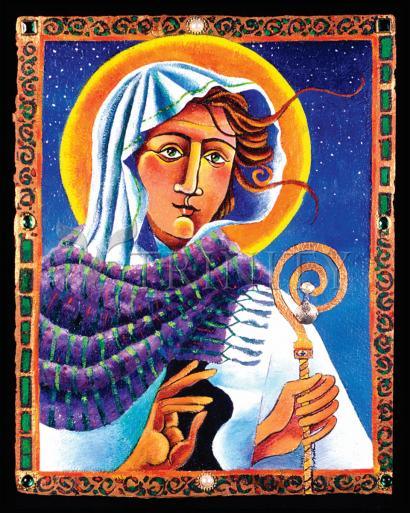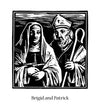Collection: St. Brigid

-
Sale
Wood Plaque Premium
Regular price From $99.95 USDRegular priceUnit price per$111.06 USDSale price From $99.95 USDSale -
Sale
Wood Plaque
Regular price From $34.95 USDRegular priceUnit price per$38.83 USDSale price From $34.95 USDSale -
Sale
Wall Frame Espresso
Regular price From $109.95 USDRegular priceUnit price per$122.17 USDSale price From $109.95 USDSale -
Sale
Wall Frame Gold
Regular price From $109.95 USDRegular priceUnit price per$122.17 USDSale price From $109.95 USDSale -
Sale
Wall Frame Black
Regular price From $109.95 USDRegular priceUnit price per$122.17 USDSale price From $109.95 USDSale -
Sale
Canvas Print
Regular price From $84.95 USDRegular priceUnit price per$94.39 USDSale price From $84.95 USDSale -
Sale
Metal Print
Regular price From $94.95 USDRegular priceUnit price per$105.50 USDSale price From $94.95 USDSale -
Sale
Acrylic Print
Regular price From $94.95 USDRegular priceUnit price per$105.50 USDSale price From $94.95 USDSale -
Sale
Giclée Print
Regular price From $19.95 USDRegular priceUnit price per$22.17 USDSale price From $19.95 USDSale -
Custom Text Note Card
Regular price From $300.00 USDRegular priceUnit price per$333.33 USDSale price From $300.00 USDSale
ARTIST: Br. Mickey McGrath, OSFS
ARTWORK NARRATIVE:
Prayer to St. Brigid
You were a woman of peace.
You brought harmony where there was conflict.
You brought light to the darkness.
You brought hope to the downcast.
May the mantle of your peace cover those who are troubled and anxious,
and may peace be firmly rooted in our hearts and in our world.
Inspire us to act justly and to reverence all God has made.
Brigid you were a voice for the wounded and the weary.
Strengthen what is weak within us.
Calm us into a quietness that heals and listens.
May we grow each day into greater wholeness in mind, body and spirit.
Amen.
Her feast day is February 1.
- Art Collection:
-
Saints & Angels
- Patronage:
-
Watermen,
-
Travelers,
-
Scholars,
-
Sailors,
-
Poultry Farmers,
-
Poets,
-
Nuns,
-
Newborn Babies,
-
Midwives,
-
Mariners,
-
Ireland,
-
Infants,
-
Fugitives,
-
Dairy Workers,
-
Children of Unwed Parents,
-
Cattle,
-
Boatmen,
-
Blacksmiths,
-
Babies
- McGrath collection:
-
Saints
From age seven on, Bridget had visions of Christ crucified. Her visions formed the basis for her activity—always with the emphasis on charity rather than spiritual favors.
She lived her married life in the court of the Swedish king Magnus II. Mother of eight children (the second eldest was St. Catherine of Sweden), she lived the strict life of a penitent after her husband's death.
Bridget constantly strove to exert her good influence over Magnus; while never fully reforming, he did give her land and buildings to found a monastery for men and women. This group eventually expanded into an Order known as the Bridgetines (still in existence).
In 1350, a year of jubilee, Bridget braved a plague-stricken Europe to make a pilgrimage to Rome. Although she never returned to Sweden, her years in Rome were far from happy, being hounded by debts and by opposition to her work against Church abuses.
A final pilgrimage to the Holy Land, marred by shipwreck and the death of her son, Charles, eventually led to her death in 1373. In 1999, she, Saints Catherine of Siena (April 29) and Teresa Benedicts of the Cross (Edith Stein, August 9) were named co-patronesses of Europe.
Born: 450 at Faughart, County Louth, Ireland
Died: February 1, 525 at Kildare, Ireland of natural causes; buried in Downpatrick, Ireland with St. Patrick and St. Columba; head removed to Jesuit church in Lisbon, Portugal
Additional Items Our Customers Like
-

St. Brigid (by Brenda Nippert)
-

St. Brigid (by Brenda Nippert)
-

St. Brigid of 100,000 Welcomes (by Br. Mickey McGrath, OSFS)
-

St. Brigid of Ireland (by Lewis Williams, OFS)
-

St. Brigid's Lake of Beer (by Br. Mickey McGrath, OSFS)
-

Sts. Brigid and Darlughdach of Kildare (by Br. Robert Lentz, OFM)
-

Sts. Brigid and Patrick (by Julie Lonneman)



















